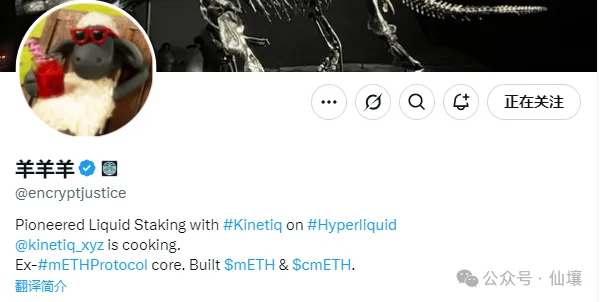Interviewee | Shawn, LSD Project Developer in Hyperliquid Ecosystem
The recent Jelly short squeeze incident on Hyperliquid and the subsequent series of public opinion have become a hot industry topic. Many people are criticizing Hyperliquid while taking sides with centralized exchanges like Binance and OKX, advocating for the "superiority of centralized exchanges".
In response, the "Xianrang" team conducted an in-depth dialogue with Shawn, an LSD project developer in the Hyperliquid ecosystem, discussing Hyperliquid's technical architecture, current status, shortcomings exposed by the Jelly incident, optimization methods, the rationality of KOLs attacking Hyperliquid on behalf of centralized exchanges, and future development trends in the exchange track.
Below is the text version of this interview, and readers are welcome to peruse.
1. Wuyue: Could you briefly introduce yourself?
Shawn: I entered the industry in 2017 and have been working in technology, including wallet development, exchange backend support, and public chain-related development. I previously worked on blockchain network maintenance and on-chain protocol development at Mantle, and now I'm working on projects within the Hyperliquid ecosystem. What I'm doing is similar to an LST within the Hyperliquid ecosystem, where users can stake HYPE tokens and receive our issued LST tokens.
Users can deposit HYPE in the protocol to automatically earn rewards. These assets will be used for Validator staking on the Hyperliquid chain, and the oracle will send earnings data back to the on-chain contract. The entire asset flow is self-custodial, which essentially achieves decentralization. This maximally guarantees asset safety for both users and the protocol.

Meanwhile, Hyperliquid, as a DEX, uses liquidity pools and vaults as counterparties for contract traders. For example, when we open a long position, it will open a short position as a hedge, or provide a counterparty with liquidity when we close the position. The HLP vault provides this counterparty and position takeover function. When a user opens a short position, the HLP vault will open a corresponding position. When this short position is liquidated, it will close the position. So during the liquidation process, it will continuously buy and close positions, creating a spiral effect.
The issue is that when the off-market price rises, short positions will inevitably be liquidated, and the short side will continuously withdraw margin to intentionally increase position risk. When the holder's liquidation margin loss is minimal, the additional penetrating position risk is borne by HLP.
This is currently a controversial area, involving the mechanism design of passive market-making pools. When attempting to entrust liquidation tasks with a fixed strategy, risks will certainly exist. When this mechanism is abused, such as more and more small-cap projects squeezing the HLP vault, all users in HLP will bear the losses of being squeezed.
The problem exposed is that when managing small-cap risk products, users cannot be allowed to open positions of arbitrary size. We must certainly restrict the size and leverage of user positions based on metrics such as market value, token distribution, and off-market liquidity depth.
Many centralized exchanges have detailed risk control levels for small-cap projects, especially for futures projects. For example, Bybit and OKX's futures have experimental zones that have a comprehensive risk control system for the project's market value, token concentration, on-chain liquidity pool depth, number of price sources, potential oracle price manipulation, and price indicator robustness. One exchange seems to have a clear rule that small-cap projects can open contracts of up to $250,000. Hyperliquid clearly lacks experience in this area, forcing HLP to bear the risk of contract liquidation penetration.
Considering that Hyperliquid originated as a market maker, market makers may focus more on a token's liquidity itself rather than considering the issue from the platform's perspective. After a whale used 50x leverage on Hyperliquid to cause trouble, Hyperliquid reduced the maximum leverage for BTC and ETH, but this decision seems to lack a comprehensive risk assessment to prevent similar risk scenarios.
Additionally, Hyperliquid needs to add a dynamic adjustment mechanism for the relationship between OI Caps and Market Caps in HLP vault risk management. For high-risk assets, for example, if we already hold a 1M contract long position, when the asset's market value continues to decline, the system should gradually reduce positions and dynamically adjust all contract positions holding that asset. Furthermore, after the market value drops, the maximum position might be limited to below 1M. These methods can help reduce the risk of the vault taking over and liquidating user positions.
So this time Hyperliquid encountered the Jelly squeeze, I understand that one must stand correctly and hope to take this lesson seriously, but this does not mean Hyperliquid did anything to let down users, this is not a serious problem.
Considering that Hyperliquid's token listing is a permissionless Dutch auction-style approach, this decentralized listing method is actually beneficial to industry development but brings potential risks to the trading platform itself. Perhaps in the future, Hyperliquid can introduce an AI Agent + on-chain voting method to screen listing objects, using an AI evaluation system and an open, transparent risk control and governance system to introduce and delist tokens, thereby reducing the shortcomings of permissionless listing.
5. Fog Moon: What do you think about many KOLs clearly taking sides with centralized exchanges like Bybit and OKX, attacking Hyperliquid for "not being decentralized"?
Shawn: This is the question I most want to answer. Bybit has a clear plan to vigorously develop BSC, diverting users and assets to support its own exchange, walking on two legs. From last year's small bull market, many KOLs made money on the Solana chain and achieved results. Then CZ, seeing this, planned to replay what happened on the Solana chain on BSC, actively promoting memecoins on the BSC chain, but we won't elaborate on who ultimately earned more in this process.
Regarding Hyperliquid, it launched its mainnet in November last year. Based on its architectural system, it can do more expansion on the application chain side, such as moving Solana VM and MOVE VM into its ecosystem, like creating a Layer2 with HyperEVM. Clearly, Hyperliquid can expand horizontally and is more flexible than centralized exchanges, so Hyperliquid is essentially digging the grave of centralized exchanges, and commercial competition is inevitable.
But the question is, what is the founders' attitude towards competitors? Is it more about self-improvement or pulling others down? This is worth pondering. We won't discuss pulling down or anything, but in this cycle, OKX and Bybit have certainly been most impacted by on-chain exchanges, and they would naturally try to minimize this impact. These are open strategies and normal commercial competition.
But I find it puzzling why suddenly so many KOLs are promoting centralized exchanges, saying HLP had a position penetration, therefore Hyperliquid is not good. This criticism clearly elevates a local phenomenon to the whole. Can a scar on your face prove you're not capable? Many KOLs' criticism of Hyperliquid gives this impression.
For basic industry competition, I don't think we need to beautify or uglify anyone, let alone promote how centralized is better than decentralized. The key issue is not here.
Moreover, competition is not shameful. Everyone hopes to promote industry progress and do good things, but centralized exchanges are inherently flawed and need to maintain a diligent attitude. As entities earning transaction fees, they should focus on their core work rather than doing contradictory things. Throwing mud at others or attacking competitors through a KOL matrix is definitely not something noble.
6. Fog Moon: What is your judgment about future development trends? What are your views on the exchange track?
Shawn: If we talk about this, we can broadly discuss. From last November to early this year, the small bull market, including the AI Agent concept coin boom, all occurred on-chain. These phenomena are inevitable trends. Platforms like gmgn's tools are becoming more mature, users are becoming better at discovering early projects, and growing tired of VC coins are all natural developments.
Now many projects won't even do VC rounds, instead directly issuing tokens on-chain in a PVP format, letting those good at discovery vote out quality projects. This is terrifying and will leave VCs without food. So currently, not just exchanges are anxious, VCs are too. They feel they need to sink down to mining gold on-chain like ordinary users.
Including many projects in the Hyperliquid ecosystem that didn't receive grants, they're sustained by HYPE airdrops. Including the project I'm working on. Moving more things on-chain helps develop an open ecosystem, rather than becoming increasingly closed.
Hyperliquid hasn't become increasingly closed like Ethereum. First, it provides users with generous airdrops, and the platform has hundreds of billions in daily trading volume, with all transaction fees used to repurchase HYPE tokens, leading to some good results. In the future, HYPE will be a deflationary model, overall quite stable. Simply put, more people who are good at discovering value need to pay attention to who is actually doing things in the Hyperliquid ecosystem.
So I believe that as an exchange, what kind of attitude they hold in doing things, whether they are promoting industry development and providing a bottom line for the industry, or engaging in malicious actions with various sarcastic attitudes. Including how CZ tried to backstab Bybit after it was stolen by North Korean hackers, which everyone can see.
Centralized exchanges will never lead the blockchain industry; they are merely extractive services. Although they have large scale and good revenue, they will never be leaders. The future is destined to belong to decentralized projects and platforms, and the gradual decline of custodial centralized exchanges is inevitable. Users' demand for self-custody, censorship resistance, and anonymity is an irresistible trend.







